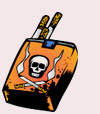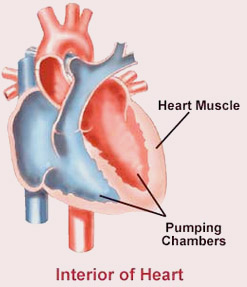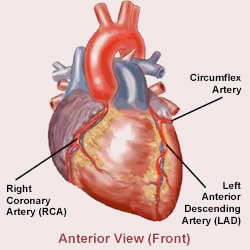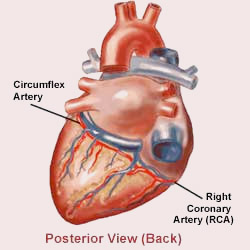Heart Disease Risk Factors

* Family history
* Smoking
* Obesity
* Diabetes
* Hypertension
You can control some of these risk factors, others you cannot.
It is very important to evaluate what steps you can take to prevent disease or to try to prevent further problems in the future. Some general steps to take now:
* Quit smoking
* Exercise
* Eat a healthy low-fat, low-cholesterol, low-sodium diet
* Gain control of handling your stress positively
* Keep your weight in a normal range · See your doctor for regular checkups
* Control your blood sugar if you have diabetes
* Follow your doctor's orders for taking medications
* Get treatment for high blood pressure. Don't ignore any warning signs
Please check with your physician before starting an exercise program.
Heart Attacks
A heart attack is a catastrophic loss of heart "pumping" function which can lead to permanent disability or death in a short period of time. To understand what a heart attack actually is, one must first understand a little bit about the function of the heart; then what a heart attack does to the body is much clearer.
The heart is a pump made up of a 1 pound ring of heart muscle surrounding two oval shaped chambers that contain and pump blood. To pump the blood, the muscle expands and contracts 60 - 100 times per minute. There are two valves that regulate the flow of blood into each chamber with a total of four valves being involved. Two of the valves allow one-way blood flow from the veins into the lung arteries (to pick up oxygen). The other valves are involved in blood flowing from the lungs into the body. Blood does not normally flow backward in the heart.
The pumping chambers themselves are made up of muscle tissue, which is nourished by three arteries that branch into separate regions of the heart muscle. The front, or tip, of the heart is supplied by the
LAD artery, which supplies about 40% of the heart muscle with blood. The underside artery is the
RCA, which supplies around 30% of the blood to the heart. The back and side of the heart are supplied by the
circumflex, which also supplies around 30% of the blood to the heart. For normal functioning, the heart muscle requires adequate blood supply to each section to ensure that the muscle tissue is receiving necessary energy and nutrients.
What is a Heart Attack?
For a heart attack to occur, there is usually a severe narrowing or complete closure of an artery (
see coronary artery disease) that nourishes the heart muscle, usually over a 10-60 minute period of time. With a major reduction of blood flow, the muscle is starved for oxygen and becomes irritable and weak. As minutes pass (up to 4-6 hours), the heart muscle in the region supplied by the blocked artery struggles for life. After 3-6 hours, the muscle begins to die. If the period of total blockage is 12 hours or more, the heart muscle in that region is seriously damaged and much of that muscle dies completely and becomes a scar.
Treatment
Heart attacks frequently involve a blood clot developing on the surface of an already diseased artery. This causes the artery to narrow or close completely. Thus the treatment of the problem is directed toward dissolving the blood clot or opening the artery by some mechanical method.
The first step of treatment involves the administration of aspirin, which is a blood thinner (in and of itself can improve heart attack survival in most patients). A beta-blocker is often administered to preserve the heart muscle and to enable it to function better even though it is seriously deprived of blood supply and oxygen. It is also recommended that an ACE inhibitor such as Vasotec, Capoten, etc. be administered to prevent the heart from deteriorating as a result of the heart attack damage.
Additional Treatment Options
With the closure of a heart artery by a blood clot, oftentimes a very potent blood thinner is administered intravenously, which can actually dissolve the blood clot and open up the artery in a biochemical manner.
It has also been found that various mechanical methods can be utilized to open up a blocked heart artery quickly. These methods include
angioplasty and the associated use of the support structure, a
coronary stent. Angioplasty is used to force an artery open and then to keep it open by permanently implanting a stent inside. There are advantages and disadvantages to both the biochemical opening up of the vessel and the mechanical angioplasty procedure. In general, however, angioplasty is probably as good as, if not better than, the use of the biochemical clot dissolving method.
Note: the artery can be opened by the clot dissolving method and any residual narrowing can be opened by angioplasty hours, days, or even weeks later.
Whether or not a
catheterization and/or angioplasty, etc. are done during an admission for a heart attack is dependent upon a number of factors. This decision can best be made by the primary care physician and cardiologist involved in the case.
After a Heart Attack
Once the artery is open, the heart muscle receives a marked increase in or a normal amount of blood and the damage, which was ongoing, ceases. The patient then recovers and is dismissed with the problem resolved or greatly improved.
Technology in the heart attack area has caused a major revolution in the care of patients and a significant improvement in the way patients with heart attacks do. Basically, the natural history of heart attack is much improved because we have additional therapies for the problem. We are now able to alter the way that Mother Nature functions in a heart attack. New methods and therapies have enabled us to stop the damage to the heart muscle almost immediately
.
Coronary Artery Disease

Hardening of the arteries, or atherosclerosis, is when the inner walls of an artery become narrow due to a buildup of cells, fat and cholesterol, called plaque.
Blood that tries to flow through the clogged artery can form a clot. If this clot cuts off the necessary blood flow to the heart muscle supplied by that artery, it begins to die. This causes a heart attack or myocardial infarction.
You should get help by calling your doctor or going to an urgent care facility if you experience any of these warning signs of a heart attack:
*
An uncomfortable heavy feeling, pressure, pain or squeezing sensation in your chest that lasts more than just a few minutes.
*
Pain or discomfort that foes into your shoulders, neck or arms.
*
Discomfort as above associated along with shortness of breath, dizziness, sweating, nausea, fainting or lightheadedness
Please read our disclaimer.






 Hardening of the arteries, or atherosclerosis, is when the inner walls of an artery become narrow due to a buildup of cells, fat and cholesterol, called plaque.
Hardening of the arteries, or atherosclerosis, is when the inner walls of an artery become narrow due to a buildup of cells, fat and cholesterol, called plaque.